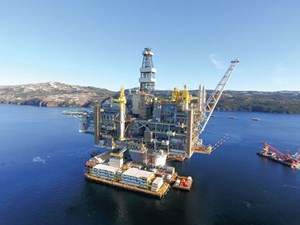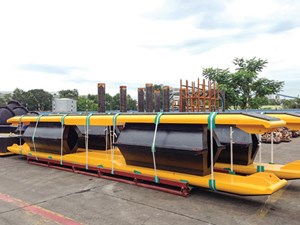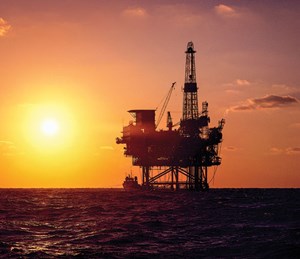Ensuring precision floatover mating
As the oil and gas industry is forced to work harder to extract oil from around the globe, reliance on reserves in remote offshore locations is increasing. As a result, there’s been a resurgence in floatover installation practices. This is becoming the technique of choice to install topsides into place, versus using heavy lift cranes. Its impact, in terms of overcoming logistical challenges posed by complex, costly platform manoeuvres, is significant for engineering at sea.
In this article, we consider the factors affecting operators, and look at how the use of floatover technology can help reduce costs and eliminate downtime.
Operators are demanding bigger, heavier platforms to increase their E&P effectiveness. Currently, one in six topside units weighs more than 12,000 tonnes, with the world’s heaviest weighing an enormous 47,830 tonnes. This means that floatover installations are growing in numbers, as they become the most efficient, effective way to install the increasingly larger platforms.
Indeed, floatover installation techniques are being favored over the traditional crane method, not only because they can handle over three times the weight, but also because the cost of crane time can run into several hundred-thousand dollars per day—a cost that is eliminated immediately with a floatover. Further, only one transportation vessel is needed for installation, and nearly all of the work to construct the topsides can be completed in the fabrication yard, resulting in lower labor costs.
Taking all of these factors into account, a research paper by marine contractor, Dockwise Ltd., said that use of floatover installations between 2014 and 2018 is predicted to grow 38%, so that an estimated 52% of all installations will be conducted in this manner.
MARGIN OF ERROR
Expert management and execution of a floatover installation is crucial for ensuring that both the topsides and the jacket legs are fitted together, safely and securely. This brings some complexities with it, and failure to get this right the first time, every time, means that there are implications for the safety, timeline and cost of the job, and the personnel involved.

Critical to this is the mating hardware used to connect the jacket with the topsides. Leg mating units (LMUs) are in operation for a short duration, but if the product fails in this small window, huge damage can be caused, and long delays may result. Consisting of steel structures incorporating engineered elastomeric pads, LMUs (Fig. 1) make the transition possible by dampening the forces created, as the topside’s load is transferred to the jacket structure.
The elastomeric pads are designed to take up the static and dynamic forces of the topsides structure, as well as the horizontal forces, due to open sea motions during the floatover mating operation. The vertical elastomer pads are normally complemented with horizontal elastomeric pads to handle this movement.
Using data provided by an offshore consultant on the expected loads and movements, the elastomeric pads must be engineered and calculated carefully with non-linear finite element analysis (FEA), to achieve the expected spring stiffness for this crucial task. Similarly, the correct formula of rubber must be used to handle the loads placed on it. Polymer is very complex and unpredictable, and only a supplier with specific knowledge and understanding of polymer behaviors can supply the most suitable solution for the job. This attention to detail is vital, especially in a market where there is very little margin for error.

Likewise, rubber deck support units (DSUs) are also important components for safe floatover operations. The topsides are loaded onto the transportation vessel with a deck support frame, and the DSUs are then placed between them, to absorb the weight of the topsides. This enables the LMUs and DSUs to work together in sync during the mating process. When the transport barge reaches the installation site, and it maneuvers between the jacket legs and begins to ballast, decompression occurs on the DSUs and vertical compression happens on the LMUs.
Finally, rubber fender systems (Fig. 2) are commonly used to absorb the impact of the heavy vessel and the jacket legs, as it moves in the tidal swell during the mating operation. Some sway and surge fenders can contribute to the failure of a floatover process, if they are not designed properly, by not sufficiently protecting the platform jacket to which the topsides are mated. If the jacket legs are compromised, long, costly delays can be caused to a project, as was witnessed in the South China Sea.
CASE STUDY: SOUTH CHINA SEA
Trelleborg’s engineered products operation fast-tracked the manufacturing, testing and delivery of its floatover mating technology for a major oilfield project in the South China Sea, in just four months. The project previously experienced an unsuccessful floatover operation in August 2013, causing structural damage to the barge and the jacket. As such, an overhaul of the floatover system was required, and the vendor was contracted to provide a customized solution to the project, as quickly as possible. This allowed the stalled project to quickly and safely commence installation, ending an 11-month delay and an escalation of costs.
Contracted by Ashburn Offshore Oil & Gas Equipment & Engineering Company Ltd., the vendor designed, fabricated and delivered eight LMUs—four inner legs and four outer legs—and floatover fenders. With the topsides weighing 12,500 tonnes, each LMU was designed with a load capacity of 1,800 tonnes.
The project suffered setbacks during its initial installation attempt, and it was at this point that the vendor was contracted to supply floatover technology. It also supplied customized sway and surge fenders to absorb any kinetic forces that the floatover barge would exert on the jacket. This ensured that the floatover process, especially when installing the topsides onto the jacket, was completely safe for both the topsides and jacket structures. In conjunction with its fenders, the high performance LMUs were easily able to support the weight of the topsides and maintain stability during installation, even in high, sea swell conditions.
There was a lot of pressure to get the project right, in light of previous events, and the project required fast, quality solutions that would perform perfectly. The vendor’s solution guaranteed reliability and provided a rapid method to get the platform online, as fast as possible, given previous delays.
Trelleborg managed to decrease its throughput time from manufacture to delivery, when the urgency of the project was realized, to ensure a concise, fast turnaround. Extra shifts and staff were assigned to ensure that the contractor’s needs were met. The vendor manufactured, tested and delivered the solutions in just four months, making the project’s second floatover process a success.
FINDING THE RIGHT SOLUTION
It’s clear from real-life examples that finding the right partner, with the right capabilities, is crucial to success, and that failure to do so can quite literally lead to the collapse or stalling of a project. Failure costs time and money, and in some cases it delays oil development for extended periods of time.

It’s not just a case of finding a partner with the right capabilities—crucial to success is how early a partner is involved with the expertise to deliver to a brief. In addition, rather than saving on the cost of the components involved, it’s even more valuable to work with suppliers that have a strong track record and proof of capability. If the manufacturer is not engaged at the front-end engineering design (FEED) stage, project decisions can be made, which could negatively impact the platform’s overall design and performance, Fig. 3.
In the case of floatover installations, the rubber components—LMUs, DSUs and sway and surge fenders—must have a high-performance specification. A supplier with in-house rubber compound technology can produce the very best solution, on a project-by-project basis. Each solution should be purpose-engineered to meet the project requirements, and to eliminate the chance of failure and costly delay. Solutions must be right the first time, every time. Calculations and analyses need to be conducted, so that components are in-line with the size of the topsides and their increasing weight, accordingly.
Testing is also imperative, as weather and sea conditions are affected by locations, impacting on vessels in numerous ways. It’s important to choose a supplier with the ability to perform full-size LMU compression testing, to maximum design-factored load capacity, and to test all LMU elastomeric pads to verify their behavior prior to installation.
As platforms continue to get bigger and heavier, the time, cost and logistical challenges surrounding them means the engineering expertise behind their deployment is in much greater demand. That extends to the rubber components that have the ability to make or break a floatover installation. Working with a global supplier, with the right solutions, expertise and control over end-to-end processes, means that operators can rest assured that they can keep up with floatover practices against the backdrop of the challenges they increasingly face. ![]()


